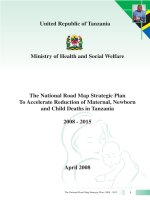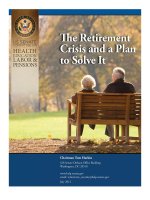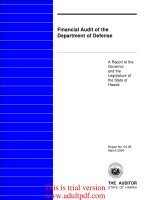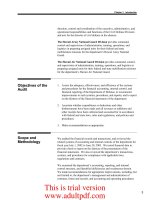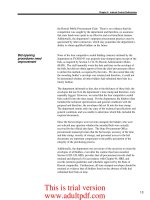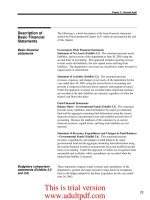The Retirement Crisis and a Plan to Solve It doc
Bạn đang xem bản rút gọn của tài liệu. Xem và tải ngay bản đầy đủ của tài liệu tại đây (727.38 KB, 10 trang )
e Retirement
Crisis and a Plan
to Solve It
Chairman Tom Harkin
428 Senate Dirksen Office Building
Washington, DC 20510
www.help.senate.gov
email:
July 2012
LETTER FROM THE CHAIRMAN
After a lifetime of hard work, people deserve the opportunity to live out their golden years
with dignity and financial independence. But for most of the middle class, the dream of a secure
retirement is slipping out of reach. We are facing a retirement crisis. Consider the following:
• e retirement income deficit – i.e., the difference between what people have
saved for retirement and what they should have at this point – is $6.6 trillion;
• Only one in five people in the private sector workforce has a defined benefit
pension plan; and
• Half of Americans have less than $10,000 in savings.
e retirement crisis will have significant repercussions. As older Americans transition out
of the workforce, either voluntarily or involuntarily, many will find that they cannot afford basic
living expenses. ey will be forced to make the difficult choice between putting food on the
table and buying their medication. e retirement crisis will put an enormous strain on our
families, our communities, and our social safety net.
e retirement crisis is directly attributable to the breakdown of the traditional “three-legged
stool” of retirement security – pensions, savings, and Social Security. Defined benefit pension
plans used to play an enormous role in providing a reliable source of retirement income, but the
pension system has been in decline for decades. At the same time, stagnant wages and rising
costs are making it harder and harder to build up a nest egg through a retirement savings plan
(e.g., a 401(k) or IRA) or otherwise. Fortunately, Social Security is still strong, but it was always
intended to be supplemented by other sources of retirement income.
I am committed to ensuring that middle class families have a secure retirement. at is
why I have been holding a series of hearings in the Senate Committee on Health, Education,
Labor, and Pensions to highlight the state of retirement security and better understand how
we can improve the system. is report summarizes the key findings from those hearings and
includes two bold proposals to address the retirement crisis. Specifically, I propose providing
universal access to a new type of retirement plan – Universal, Secure, and Adaptable (“USA”)
Retirement Funds – that can deliver real retirement security for all working Americans. I have
also proposed improvements to Social Security that will increase benefits and make the program
stronger for future generations.
I intend for this report to be the starting place in an evolving discussion about retirement
security. Over the coming months, I plan to bring together business and labor leaders, policy
experts, advocates, and my fellow lawmakers to implement necessary reforms. e retirement
crisis is simply too big to ignore, and it is time for us to roll up our sleeves and get to work.
Sincerely,
Senator Tom Harkin
Chairman
US Senate HELP Committee | JULY 2012
2
“Retirement.” e word used to conjure up images of
travelling, pursuing new hobbies, or spending time with
the grandkids. But these days, when people think about
retirement, all they do is worry. Not having enough savings
for retirement is one of people’s biggest economic fears,
and a recent survey found that 92% of people think there
is a retirement crisis in America.
1
Retirement (In)security
As a country, we are woefully unprepared for retirement.
Half of all Americans have less than $10,000 in savings,
and nearly half of the oldest Baby Boomers are at risk of
not having sufficient retirement resources to pay for basic
retirement expenses and healthcare costs.
2
e Center for
Retirement Research at Boston College estimates that our
“retirement income deficit” is $6.6 trillion.
3
at number
represents the gap between the pension and retirement
savings that American households have today and what
they should have today to maintain
their standard of living in retirement. at is enough
dollars that, if lined up end to end, they would stretch
to the moon and back 1,000 times and still leave enough
left over to pay NASA’s budget for the next eight decades.
e public is becoming increasingly concerned about
the lack of retirement security. Only 14% of people say
they are very confident they will have enough money to
live comfortably in retirement.
4
at is down 9% since
2002.
5
And 69% of people believe they could save until age
65 and still not have enough.
6
Employers are even more
pessimistic; only 4% are “very confident” their employees
will retire with sufficient assets. at is down from 30%
in 2011.
7
Breakdown of the Three-legged Stool
e retirement crisis is directly attributable to the
failure of the “three-legged stool” of retirement security.
Traditionally, defined benefit pension plans (“pensions”),
personal savings, and Social Security were seen as the three
pillars creating a solid foundation for our retirement system.
Each should play an important role in supporting people
in old age. However, the stool, never sturdy, has become
increasingly wobbly as pensions have disappeared and the
middle class is finding it harder and harder to save.
Disappearing Pensions
Defined benefit pensions – which provide people with
a lifetime benefit based on a formula that usually takes
into account a person’s years of service and salary – used
to play an enormous role in providing a safe and secure
retirement for many in the middle class. Although coverage
has never been universal, pensions have successfully helped
millions of people prepare for retirement by providing a
secure, guaranteed benefit for life. Pensions are regulated
to protect participants against mismanagement, and they
shield people from the risk of market downturns and the
possibility of living longer than expected. However, the
pension system has been in a steady decline for decades,
and now, only one out of every five people working in the
private sector has a pension.
8
ese days, employers have largely stopped offering
pensions at all. ose that choose to offer their employees
a retirement plan tend to provide defined contribution
plans (“DC Plans”), such as 401(k) plans. DC Plans
allow people to save for retirement on a tax-advantaged
basis and are more attractive to many employers because
they shift virtually all of the risks associated with the plan
to employees. Employers typically are not responsible for
investment losses in a DC Plan, and they are not required
to make contributions for their employees. DC Plans
can be an effective way to help people save for retirement,
but they are not a substitute for pensions because they do
not provide people with the same level of protection from
THE RETIREMENT CRISIS
“I, like millions of people
in this country, have
worked all my life, and I
have worked very hard.
And I have no retirement savings at
all. None.”
Karen O’Quinn
US Senate HELP Committee | JULY 2012
3
financial risk and do not provide a guaranteed stream of
income for life.
e decline of the traditional pension is going to have
real consequences for individuals and families. Pensions are
one of the simplest, most cost-effective means of securing
a source of retirement income and an important source of
protection for families against economic risk. ey are also
an extremely effective means of keeping older Americans out
of poverty. Research indicates
that the poverty rate in 2010
for older households lacking
pension income was nine
times greater when compared
to households with pension
income.
9
In addition to providing
economic security to
individuals, pensions
provide enormous benefits
to our economy and play
an instrumental role in job
creation.
10
Every dollar that
goes into a pension plan is held
in trust for a benefit that may
not need to be paid for 40 years
or more. Consequently, pensions are able to invest those
dollars over long time horizons. at means they are able
to provide critical sources of financing for long-term projects
like technology and infrastructure development.
11
Pensions
are also able to make investments in good times and bad, so
they are an important source of liquidity during economic
downturns, such as the Great Recession, when banks and
other financial institutions slow or stop their lending. In
short, pensions make the kinds of consistent, long-term
investments in our economy that spur innovation and create
jobs. As pensions disappear, we are losing a key source of
investment capital and a driving force behind our economy.
Retirement Savings & the Middle Class Squeeze
At the same time as middle class families have seen
their pensions disappear, economic conditions are making
it tougher and tougher for people to save through DC
Plans or on their own.
12
People are working longer and
harder than ever before, and productivity has steadily
increased. However, worker compensation has been flat
or negative over the past four decades, and costs of living
have been increasing. e middle class is being squeezed,
and we are at a point where half of households would not
even be able come up with $2,000 in 30 days if faced
with an emergency.
13
For many years, families were able
to mask the effects of stagnant wages and rising costs by
becoming two-income households, working more, and
relying on credit. But the Great Recession exhausted
those coping mechanisms and exposed the underlying
economic challenges facing the middle class.
14
Now, the
middle class is struggling just to keep its head above water.
With the significant
economic challenges facing
families, it should be no surprise
that the middle class finds it
difficult to save. As noted
above, half of Americans have
less than $10,000 in savings,
and 60% of the population
has less than $25,000. ere
have been many positive
developments to help people
save by expanding access to
DC Plans and facilitating
automatic savings. However,
despite all of those efforts,
savings rates are still too low,
and people are less likely to
report that they are saving for
retirement than just a decade ago.
15
Social Security: Strong but Not Enough
Fortunately, Social Security continues to provide
families with a basic level of income security. It prevents
millions of Americans from slipping into poverty when
their working years are over because, like a pension, Social
Security provides Americans with an income stream that
they cannot outlive. However, Social Security was never
meant to be people’s sole source of retirement income.
e program replaces only about 40% of the average
person’s income after retiring, but people typically need
65-85% percent of pre-retirement earnings to maintain
their standard of living.
16
us, a robust private retirement
system is absolutely essential to give ordinary people an
opportunity to retire.
Cost of the Crisis
e breakdown of the three-legged stool of retirement
security and the resulting retirement crisis are going to have
very real costs. In 2010, nearly 6 million Americans aged 65
and over were living in poverty or near-poverty.
17
By 2020,
“Pensions are vitally important
for keeping older Americans out of
poverty. e poverty rate in 2010
for older US households lacking
pension income was nine times
greater as compared to households
with pension income.”
Diane Oakley
National Institute on Retirement Security
US Senate HELP Committee | JULY 2012
4
that number is expected to increase by 33%. Given that an
increasing number of older people are reaching retirement
age without income to supplement Social Security, we
could see even higher poverty rates in the future. is
trend will place enormous new burdens on families, and
it will strain our social safety net, which is already facing
significant financial constraints.
Older people without adequate retirement savings will
have trouble just making ends meet. Many will need long-
term care, but few seniors will be able to afford it. As a
result, they will have to rely on their families for support.
is will put a strain on working families, who are already
struggling to cope with stagnant wages, rising living costs,
and the lingering effects of the Great Recession. It will also
make it more difficult for younger family members to save
for their own retirement.
In addition to the strain on families, the retirement crisis
will have a significant impact on government programs that
provide assistance to poor or near-poor retirees. As people
are unable to afford basic living expenses in retirement, they
will rely more and more on programs like housing assistance,
home heating aid, and food assistance. Elder poverty will
also increase Medicare and Medicaid costs because seniors
living in or near poverty often have higher incidences of
chronic and acute health problems and are also less able to
afford private long-term care services. e increased costs
will undoubtedly strain our social safety net.
e retirement crisis will have a significant human cost
as well. Life will be extraordinarily difficult for seniors
without adequate income in retirement. After a lifetime
of hard work, many seniors will find themselves forced
to choose between putting food on the table and buying
their medication. And many people simply will not be
able to leave the workforce. ey will have to work well
into advanced age, eliminating job opportunities for
younger workers.
Most Americans do not expect a lavish lifestyle in
retirement, but they do want to live out their golden years
with dignity and financial independence. We need a
retirement system that gives them the opportunity to do that.
“We don’t make enough to
save and have no pension
coming… Retirement is
supposed to be a time when
you cherish your family… For me,
retirement will be the time to pick up a
second, low-paying career.”
Teresa Law
“I have paid into Social
Security. at’s one
benefit to look at down
the road. But in today’s
economy… Social Security is not
going to be enough.”
David Muse
US Senate HELP Committee | JULY 2012
5
PRINCIPLES FOR REFORM
Over the past two years, the Senate Committee on Health, Education, Labor and Pensions
has held a series of hearings on the retirement system.
18
e hearings have taken a hard look
at key aspects of the retirement system, and they have provided a clear picture of the kinds of
changes we need to ensure the system can work for everyone. ose changes can be boiled
down into the following four basic principles:
1. The retirement system should be universal and automatic.
Most people realize that they should be preparing for retirement, but it is often difficult
because they have more immediate concerns, like paying the bills and putting food on
the table. And people are frequently overwhelmed by the complexity of the financial
decisions they have to make.
19
However, when saving is easy and automatic, people are
much more likely to put money aside.
20
By ensuring that every American has access
to a retirement plan at work and making participation automatic, we can drastically
reduce the retirement income deficit and promote retirement security.
2. The retirement system should give people certainty.
e retirement system should give people certainty that they will have a reliable source
of income in retirement. It needs to provide people with the opportunity not just to
save for retirement but also to secure a predictable stream of retirement income that
they cannot outlive.
3. Retirement is a shared responsibility.
Individuals, employers, and the government all have a role to play in ensuring that
every American has the opportunity to retire with dignity and financial independence.
It is unfair for any one party to shoulder the burden alone.
4. Retirement assets should be pooled and professionally managed.
e retirement system should not force people to become investment experts. Most
people simply do not have the background, interest, or time to manage their retirement
funds effectively. Instead, it should give everyone access to prudent, professional asset
management and allow people to pool their assets with others to reduce costs and risk,
including the risk of living longer than expected.
ese four principles should form the framework for developing comprehensive solutions
to the retirement crisis. With a retirement income deficit of $6.6 trillion, the crisis is simply
too big to ignore. We cannot continue to stand idly by as average Americans struggle to save
for retirement and our seniors continue to slip into poverty.
US Senate HELP Committee | JULY 2012
6
is section lays out a two-part plan to solve the
retirement crisis by making some bold changes to the
private retirement system and Social Security. e first
proposal would rebuild the private pension system by
providing universal access to Universal, Secure, and
Adaptable (“USA”) Retirement Funds, a new type of private
pension plan that would give people the opportunity to
earn a secure benefit and would be easy for employers to
offer. e second proposal will improve Social Security
by increasing benefits while strengthening the long-term
finances of the trust fund. Together, those two reforms
would go a long way toward rebuilding the three-legged
stool of retirement security and helping people retire with
dignity and financial independence.
Part One
Rebuilding Pensions
A strong and vibrant
pension system is a core
component of a secure
retirement. However, the
pension system has been
in decline for decades, and
businesses are reluctant
to provide new pension
benefits to their employees.
Existing pension models
are simply not attractive to
many employers. It is time
for a new approach – USA
Retirement Funds.
USA Retirement Funds are innovative, privately-run,
hybrid pension plans that incorporate many of the benefits
of traditional pensions while substantially reducing the
burden on employers. Under this proposal, there would
be universal access to USA Retirement Funds through
the existing payroll withholding systems for those that
do not already have access to a retirement plan, and
anyone participating would have the opportunity to earn
a cost-effective and portable source of retirement income.
USA Retirement Funds would have professional asset
management and give people an easy way to pool their risk
with other active employees and retirees. Importantly, USA
Retirement Funds would also allow employers to offer a
secure retirement benefit without taking on management
responsibility or financial risk. at is especially important
for small businesses, which often do not have the resources
to manage a retirement plan.
Professional Management
USA Retirement Funds would be privately-run, licensed,
and regulated retirement plans. Each USA Retirement Fund
would be overseen by a board of trustees consisting of
qualified employee, retiree, and employer representatives.
e trustees would act as fiduciaries and be required to
act prudently and in the best interests of plan participants
and beneficiaries. e assets held by each USA Retirement
Fund would be pooled and professionally managed.
Lifetime Income Benefit
People participating in
a USA Retirement Fund
would earn a benefit paid
out over the course of their
retirement, with survivor
benefits, like a pension.
e amount of a person’s
monthly benefit would
be determined based
on the total amount of
contributions made by, or
on behalf of, the participant
and investment performance
over time. Because it is
nearly impossible for low-wage workers to save enough for
retirement, they would be eligible for refundable retirement
savings credits that would be contributed directly to a USA
Retirement Fund.
Risk Sharing
Pension plans have traditionally placed all of the risk,
primarily investment and longevity risk, on employers.
ose risks have discouraged employers from offering a
pension. USA Retirement Funds would make offering a
pension benefit more attractive by eliminating virtually all
risk to employers. Instead, USA Retirement Funds would
spread the risks inherent in running a pension across large
SOLUTIONS
“Risk sharing and professional
money management help make USA
Retirement Funds an efficient and
secure way to prepare for retirement.”
David Madland
Center for American Progress
US Senate HELP Committee | JULY 2012
7
groups of employees and retirees. at kind of broad risk
pooling would provide significant protection to individuals
and would reduce overall costs.
e risk sharing component of the USA Retirement
Funds would mean that benefit levels are responsive to long-
term market conditions. For example, USA Retirement
Funds would be conservatively managed, but if there were
a severe and long-term economic downturn, the trustees
could, under specified procedures, gradually adjust benefits
to reflect market realities while still providing a steady
income stream to retirees. Conversely, if a USA Retirement
Fund had better-than-expected returns, those returns
would be conservatively allocated as increased benefits
for employees and retirees. is type of risk sharing is
beneficial to participants and gives them an opportunity
to earn a cost-effective source of retirement income.
Universal Coverage
USA Retirement Funds
would ensure that every
working person in America
has access to a retirement
plan through an automatic
payroll deduction.
21
Employers that do not offer
a workplace retirement plan
with automatic enrollment
and a minimum level of
employer contributions
would have to automatically
withhold a portion of their
employees’ pay and send
such amounts to a USA Retirement Fund. e employer
could either choose a USA Retirement Fund or simply
use the “default” fund identified for the region, industry,
or through collective bargaining. Employees would be
automatically enrolled in the USA Retirement Fund at a
specified contribution level, but they could increase their
contributions, decrease their contributions, or opt out of
automatic enrollment at any time. Enrolling employees
in a USA Retirement Fund would utilize existing payroll
withholding systems, so it would involve little, if any,
additional administrative burden, and employers would
receive a credit to help off-set the cost. Importantly,
employers that already have pension plans or DC Plans
with automatic enrollment and a match would not have
to change anything.
Employer Responsibility
Because USA Retirement Funds would be licensed and
overseen by a board of trustees, employers would not have
any fiduciary responsibilities in selecting, administering, or
managing the funds. Employers’ only obligation with regard
to the USA Retirement Funds would be to automatically
enroll employees, ensure that employee contributions are
processed, and make modest contributions. Importantly,
employers would not “guarantee” the USA Retirement
Funds or have any residual responsibility to provide
additional funding or make up shortfalls.
Encouraging Competition
Competition among USA Retirement Funds will keep
costs low and ensure optimal performance. To facilitate
competition, USA Retirement Funds would be subject
to stringent transparency
requirements and would
be required to regularly
provide information on
investment performance,
funding levels, and
the projected level of
retirement benefits based
on contribution levels.
Benefits would also be
entirely portable so
that participants could
move from one USA
Retirement Fund to
another.
Coordination with Other Retirement Plans
ere are many people for whom the current system
is working, and it is important that systemic reforms
not compromise their retirement security. us, USA
Retirement Funds are not intended to replace existing
pensions. Many employers and employees have developed
excellent pension arrangements that benefit everyone
involved, and those arrangements should be allowed to
continue to flourish. Additionally, individual retirement
savings are a critical component of retirement security, so
USA Retirement Funds are intended to supplement, not
supplant, DC Plans. Employers could certainly offer both a
USA Retirement Fund and a DC Plan for their employees.
“e USA Retirement Funds and
comprehensive Social Security proposals
are bold, innovative initiatives that will
help lead our nation toward the safe and
sufficient retirement income system that
working Americans need and deserve.”
Karen W. Ferguson
Director, Pension Rights Center
US Senate HELP Committee | JULY 2012
8
Part Two
Strengthening Social Security
Social Security has proven to be an incredibly efficient
means of delivering retirement security to millions of
Americans. erefore, one of the most effective ways to
address the retirement crisis and reduce the retirement
income deficit is to improve Social Security by enhancing
benefits in a fiscally responsible way. e Rebuild America
Act (the “Act”), introduced in March 2012, contains a
comprehensive plan to improve Social Security.
22
at plan
would improve benefits to help reduce the retirement income
deficit, ensure the cost of living adjustment (“COLA”)
better corresponds to the typical expenses for seniors,
and improve the long-term
financial condition of the
trust fund by gradually
lifting the cap on wages
subject to payroll taxes.
Improved Benefits
To improve benefits for
current and future Social
Security beneficiaries, the
Act changes the method by
which the Social Security
Administration calculates
Social Security benefits.
Social Security benefits
are based on a progressive
formula that replaces a set percentage of income –
called a replacement factor – at three different income
levels. e replacement factor for a person’s first $767
of Average Indexed Monthly Earnings (“AIME”) is 90%.
e replacement factor drops to 32% for AIME between
$767 and $4,624 and 15% for AIME between $4,624
and $8,532.
e Act improves Social Security benefits by expanding
by 15% over a 10 year period the amount of earnings
covered under the first replacement factor. In other words,
it would increase the amount of AIME that receives the
90% replacement rate. at change will boost benefits
for most beneficiaries by approximately $60 a month.
Although the increase is modest, it will have an especially
profound effect for those in the middle and at the bottom
of the income distribution for whom Social Security has
become an ever greater share of their retirement income.
Improved COLA
The Act changes the way the Social Security
Administration calculates the COLA so that it more
accurately reflects the change in seniors’ cost of living.
Currently, the annual adjustment is tied to the Consumer
Price Index for all Urban Wage Earners (“CPI-W”) for
the purposes of calculating inflation. e CPI-W is based
on a basket of goods that does not adequately track the
purchases of seniors such as medical care. e Act moves
from using the CPI-W to the Consumer Price Index for the
Elderly (“CPI-E”), an index
that is specifically tailored
to more closely track costs
for seniors. Making this
change ensures that Social
Security benefits keep pace
with the rising costs of
essential items for seniors,
including health care.
Improved Financing
Social Security is not in
crisis, but it does face a long-
term deficit. According
to the most recent Social
Security Trustees report, the
trust fund will be able to pay full benefits through 2033.
23
In order to improve benefits and improve the solvency of
the trust fund, the Act would phase out the cap on wages
subject to the payroll tax, which is currently $110,100.
In other words, income above $110,100 would be subject
to the payroll tax, bringing more revenue into the Social
Security system. e change would be phased in over
a 10 year period to minimize the burden on employers
and employees. Moreover, to ensure that people receive a
benefit for every dollar they pay into the system, the Act
creates a new replacement factor of 5% for income over
the current wage cap. Together with the benefit increases
in the Act, these steps will significantly extend the life of
the Trust Fund.
24
“By expanding Social Security benefits
and improving the long-term solvency of
the program, the Rebuild America Act
demonstrates a renewed commitment to
seniors and hard-working Americans in
these turbulent times.”
Social Security Works
US Senate HELP Committee | JULY 2012
9
We are facing a retirement crisis, and at $6.6 trillion, it is simply too big to ignore. is report provides
concrete solutions to the retirement crisis. ey are intended to be a starting place in an evolving discussion,
and over the coming months, the discussion will continue on Capitol Hill, in Iowa, and across the country.
Public input on this issue is critically important, so people with ideas or stories they want to share can
contact Chairman Harkin by:
Sending emails to:
Sending letters to: Retirement Security Project
Senate Committee on Health, Education, Labor, and Pensions
428 Senate Dirksen Office Building
Washington, DC 20510
CONCLUSION
(Endnotes)
1. Allianz, Reclaiming the Future, pg.4 (2010), available at irement-
madesimpler.org/Library/ENT-991.pdf (nationwide survey of 3,257 adults
aged 44-75).
2. Employee Benefit Research Institute, Retirement Confidence Survey (2012),
available at Employee Benefit Research
Institute, e EBRI Retirement Readiness Rating (2010), available at http://
www.ebri.org/pdf/briefspdf/EBRI_IB_07-2010_No344_RRR_RSPM1.pdf.
3. Retirement USA, e Retirement Income Deficit (2011), available at http://
www.retirement-usa.org/retirement-income-deficit-0. e Employee Benefit
Research Institute has also prepared an aggregate retirement income deficit
number, taking into account current Social Security retirement benefits and
the assumption that net housing equity is utilized “as needed.” at study
estimates that the number is currently $4.3 trillion for all Baby Boomers and
Gen Xers. Employee Benefit Research Institute, Notes – Vol. 33, No. 5 (2012),
available at />RSPM-ER.Cvg1.pdf.
4. Employee Benefit Research Institute, Retirement Confidence Survey (2012).
5. Id.
6. Transamerica Center for Retirement Studies, 13th Annual Transamerica Worker
Survey (2012), available at />tc_center_research.html.
7. Aon Hewitt, 2012 Hot Topics in Retirement, pg. 5 (2012), available at http://
www.aon.com/attachments/human-capital-consulting/2012_Hot_Topics_in_
Retirement_highlights.pdf.
8. Bureau of Labor Statistics, Program Perspectives: On Defined-Benefit Plans, Vol.
2, Issue 3 (2010), available at />perspectives_vol2_issue3.pdf.
9. National Institute on Retirement Security, e Pension Factor 2012 (2012).
10. See generally U.S. Senate Committee on Health, Education, Labor, and Pen-
sions, e Power of Pensions: Building a Strong Middle Class and Strong Economy,
112
th
Cong. (July 12, 2011), available at />11. Id. (Statement of David Marchick, e Carlyle Group).
12. Senator Tom Harkin, Saving the American Dream: e Past, Present, and Uncer-
tain Future of America’s Middle Class (2011), available at ate.
gov/documents/pdf/4e5fa704f2533.pdf.
13. Annamaria Lusardi, Daniel J. Schneider and Peter Tufano, Financially Fragile
Households: Evidence and Implications, NBER Working Paper No. 17072
(2011), available at />14. Reich, Robert B., Statement to the U.S. Senate Committee on Health, Educa-
tion, Labor, and Pensions, e Endangered Middle Class: Is the American Dream
Slipping out of reach of American Families?, 112
th
Cong. (May 12, 2011), avail-
able at />15. Employee Benefit Research Institute, Retirement Confidence Survey (2012).
16. Social Security Administration, Understanding the Benefits, SSA Publication
No. 05-10024 (2012), available at
Government Accountability Office, Retirement Income: Ensuring Income
roughout Retirement Requires Difficult Choices, pg.9 (2011), available at
/>17. Department of Health and Human Services, A Profile of Older Americans
(2011), available at />docs/2011profile.pdf.
18. Recordings of all of the hearings along with written witness testimony are
available at
19. Agnew, Julie, Statement to the U.S. Senate Committee on Health, Education,
Labor, and Pensions, Simplifying Security: Encouraging Better Retirement Deci-
sions, 112
th
Cong. (Feb. 3, 2011), available at />media/doc/Agnew.pdf
20. Lucas, Lori, Statement to the U.S. Senate Committee on Health, Education,
Labor, and Pensions, Simplifying Security: Encouraging Better Retirement
Decisions, 112
th
Cong. (Feb. 3, 2011), available at ate.
gov/imo/media/doc/Lucas.pdf.
21. This feature of the proposal is similar to the administration’s proposal to
establish automatic workplace pensions. See Ofce of Management and
Budget, Fiscal Year 2013 Budget of the U.S. Government, pg. 147 (2012),
available at />fy2013/assets/budget.pdf
22. Rebuild America Act, S.2252 (March 29, 2012); H.R. 5727 (May 10, 2012).
23. Social Security Administration, 2012 OASDI Trustees Report (2012), avail-
able at />24. Stephen C. Gross, Chief Actuary of the Social Security Administration, Let-
ter to Senator Harkin (2012), available at />THarkin_20120329.pdf

